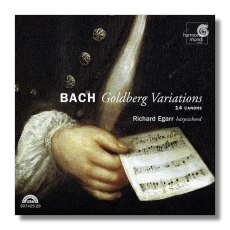
The Internet's Premier Classical Music Source
Related Links
- J.S. Bach Reviews
- Latest Reviews
- More Reviews
-
By Composer
-
Collections
DVD & Blu-ray
Books
Concert Reviews
Articles/Interviews
Software
Audio
Search Amazon
Recommended Links
Site News
 CD Review
CD Review
Johann Sebastian Bach

- Goldberg Variations, BWV 988 [90:24]
- 14 Canons on the Ground from the Goldberg Variations, BWV 1087 [8:43]
Richard Egarr, harpsichord
Recorded Vereenigde Doopsgezinde Gemeente, March 2005
Harmonia Mundi HMU907425.26 2CDs: 43:26 + 55:41
King Arthur had his quest for the Holy Grail, and Columbus searched for riches in the New World. Although not of such lofty goals, the early music keyboardist Richard Egarr searches for Bach's cantabile heaven in his new recording of the Goldberg Variations. In his booklet notes, Egarr makes his case that the harpsichord "firmly belongs within the resonant family of instruments – with the lute and harp. We must try to make it the 'machine-that-can-sing', or at least ring".
Clearly, Egarr is not happy with the tendency of harpsichordists to offer strongly-articulated phrasing which is too detached to allow Bach's singing tone to prevail. In Egarr's quest to find cantabile heaven, he uses two features of a rather unique nature. First, he employs a tuning system that has recently been advanced as the one Bach may have used for his own keyboard works. This system was researched and developed by the musicologist and early keyboard artist Bradley Lehman. Without going into the details of the research, Lehman has taken a 17th century sixth comma meantone tuning and adjusted it to accommodate the most remote key areas. In doing so, Lehman is confident that he has developed a tuning regimen that highlights the musicality and attractiveness of the harpsichord. Egarr is of like mind, and uses Lehman's tuning system to assist in reaching cantabile heaven.
The second device Egarr employs concerns seagull quills. As Egarr explains, "My instrument was thoroughly re-voiced in seagull for this recording. There is a softer-edged beginning to the sound that seems to coax the note into life rather than forcing it. It is absolutely more vocal – once again allowing Bach greater access to his desired cantabile".
Does the Lehman tuning system and use of quills have a significant effect on the musical presentation? I am convinced that these features have substantial impact. Never have I heard such fluid and elastic phrasing along with a beautiful harpsichord tone. Of course, Egarr has much to do with these effects, and I think it fair to say that he has fully succeeded in reaching Bach's cantabile heaven.
However, all is far from perfect. Egarr has placed an enormous weight on a singing and highly melodious tone to the detriment of other factors.
His articulation is generally on the weak side, and it has been quite a few years since I've heard a version of the Goldberg Variations with so little determination; pointed phrasing simply gets little attention from Egarr, and the quills do not help the matter. Perhaps most important, Egarr conveys little of the excitement, drive, and momentum of the faster variations that comes from the best harpsichord versions including those of Kenneth Gilbert on Harmonia Mundi, Gustav Leonhardt on Teldec, and Pierre Hantai on Mirare. Egarr takes the fast variations at a pace much slower than the norm, robbing them of their inherent exuberance and propulsive elements and substituting an unappealing restraint and sluggishness. Another problematic aspect is that Egarr is not interested in representing the underbelly of the human condition as Variations 9, 13, 15, and 25 (The Black Pearl) are not sufficiently characterized.
Disappointment also comes to center stage with Egarr's performance of Variation 30. In this variation, a singing tone is an absolute necessity; yet, Egarr abandons his own stated cantabile goals and offers us quite a choppy presentation.
If Egarr's version of the Goldberg Variations has value, it comes from the charm, elegance, beauty of line and elasticity of the performances.
But those felicities are not sufficient on their own to win the day.
Ultimately, in a great performance of the Goldbergs, I salivate at the thought of hearing the repeats. Although Egarr observes all of them, in not one case do I find myself eagerly awaiting them.
Egarr does add a nice filler in the form of Bach's 14 Canons on the first eight bass notes of the opening Aria of the Goldberg Variations. They were discovered in 1974 but remain infrequently recorded, no doubt because some of the canons are impossible to play by only one performer. Egarr's solution, one that likely will not sit well with purists, is to multi-track the canons requiring more than two hands. Regardless, the performance is excellent and pays less attention to a cantabile style than Egarr offers in the main work. The result is a more pointed and strongly articulated interpretation.
Don's Conclusions: For those who treasure elegance, beauty and elasticity in their Bach keyboard recordings, the new Egarr version of the Goldberg Variations should well satisfy. But those looking for a broader set of qualities might be disappointed. Personally, I find the interpretations rather soft-grained with a very low excitement/drive quotient. The booklet notes are exceptional and give a fine explanation of Egarr's motivation in making this recording; the soundstage is clear and crisp with admirable depth. If it seems that I have been straddling the fence a little, allow me to correct the situation by stating clearly that Egarr's Goldberg Variations is not one of the great recorded performances of the work.
Copyright © 2006, Don Satz




















